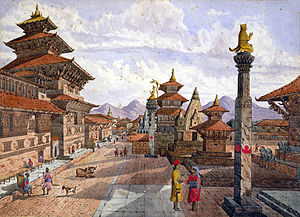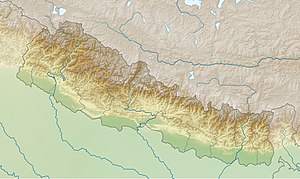
1802 map of Kathmandu Valley
The Battle of Lalitpur in 1768 ended with the Gorkha conquest of Lalitpur, one of the three kingdoms in Nepal centered in the Kathmandu Valley,[1] and the loss of the rule of the indigenous Newars.[2] Exhausted by a prolonged siege and much bloody fighting, the Newars surrendered when the Gorkhalis threatened to cut off their noses, like during the Battle of Kirtipur, and also their right arms.[3] The victors then entered the city and plundered it. They killed all the nobles and important men. They also dismantled the royal palace and looted the houses of the rich inhabitants and even the temples.[4]
The blockade[]
Lalitpur (alternative names: Patan, Yala Desa यल देस, Lalit Pattan) was one of the three capitals in the Kathmandu Valley, the other two being Kathmandu and Bhaktapur. Lalitpur contained 24,000 houses, and its southern boundary extended to a distance of four days' journey to the kingdom of Makwanpur.[5] The Gorkhalis from the neighboring kingdom of Gorkha coveted the valley due to its rich culture, trade, industry and agriculture.[6] In 1736, the Gorkhali king Nara Bhupal Shah launched an attack on Nuwakot, a border town and fort in the northwest of the valley, and was roundly defeated.[7] In 1742, his son Prithvi Narayan Shah became king and continued the quest.[8][9] Shah sought to subdue the valley by choking its commerce and supply lines. His forces occupied strategic passes in the surrounding hills, and strangled the vital trade links with Tibet and India. In 1744, Shah took Nuwakot which gave him a foothold in Nepal and allowed him to stop its trade with Tibet as it lay on the trans-Himalayan trade route.[10] In 1762 and 1763, the Gorkhalis overran Makwanpur and Dhulikhel respectively, surrounding the Kathmandu Valley from the west, south and east.[11]
In a bid to cause a famine, Shah prevented any grain from passing into the valley, and blockade runners were hung from the trees on the roads.[12] The prolonged siege forced the king of Kathmandu to appeal to the British East India Company for help. In August 1767, Captain George Kinloch led a British force towards the valley to rescue its beleaguered inhabitants.[13] He reached within 75 km of Kathmandu and captured the forts at Sindhuli and Hariharpur, but was forced to retreat after supplies ran out and his troops mutinied.[14]
Eyewitness account[]
An Italian Capuchin missionary, Father Giuseppe, Prefect of the Roman Mission, was an eyewitness to the Gorkhali invasion. He has written that after the defeat of Kirtipur, Shah sent his troops to attack Lalitpur. They surrounded half the city from the west, and began firing on it. Giuseppe's house was located near the city gate, and he moved to Kathmandu to get out of the line of fire.[15]
The take-over[]
Not being able to take Lalitpur even after a long siege and a series of fierce clashes, Shah decided to change his tactics.[16] He sent his men to infiltrate the city's nobility and make a deal. He promised the nobles that they would be allowed to keep their property, in fact, they would get more if they accepted him as their king. These secret negotiations convinced the Malla kings of Lalitpur and Kathmandu (who had sought refuge there after its capture by the Gorkhalis) that they were going to be betrayed, and they fled to Bhaktapur.[17] After Shah took Lalitpur, he treated the traitorous nobles appreciatively for a time. Then one day he called them to a meeting at the riverbank of Teku Dobhan on the outskirts of the city. There, all the Pradhan nobles were captured and killed.[18]
The Gorkhalis then turned their attention towards Bhaktapur. The three Malla kings of Nepal were gathered at Bhaktapur Durbar Square to make a final stand against the aggressors.[19] Shah conquered Bhaktapur in 1769, thus completing his conquest of Nepal. The Malla dynasty was replaced by the Shah dynasty which lasted until 2008 when Nepal became a republic.[20]
See also[]
References[]
- ↑ Northey, William Brook and Morris, Charles John (1928). The Gurkhas: Nepal-Their Manners, Customs and Country. Asian Educational Services. ISBN 9788120615779. Page 31.
- ↑ Waller, Derek J. (2004). The Pundits: British Exploration Of Tibet And Central Asia. University Press of Kentucky. p. 171. ISBN 9780813191003.
- ↑ Giuseppe, Father (1799). Account of the Kingdom of Nepal. London: Vernor and Hood. p. 319. http://books.google.com/books?id=vSsoAAAAYAAJ&pg=PA307&cad=4#v=onepage&q&f=false. Retrieved December 2, 2012.
- ↑ Northey, William Brook and Morris, Charles John (1928). The Gurkhas: Nepal-Their Manners, Customs and Country. Asian Educational Services. ISBN 9788120615779. Page 151.
- ↑ Giuseppe, Father (1799). Account of the Kingdom of Nepal. London: Vernor and Hood. p. 308. http://books.google.com/books?id=vSsoAAAAYAAJ&pg=PA307&cad=4#v=onepage&q&f=false. Retrieved December 6, 2012.
- ↑ Raj, Yogesh (2012). "Introduction". Expedition to Nepal Valley: The Journal of Captain Kinloch (August 26-October 17, 1767). Kathmandu: Jagadamba Prakashan. p. 7. ISBN 9789937851800.
- ↑ Northey, William Brook and Morris, Charles John (1928). The Gurkhas: Nepal-Their Manners, Customs and Country. Asian Educational Services. ISBN 9788120615779. Pages 30--31.
- ↑ Stiller, Ludwig F. (1968). Prithwinarayan Shah in the light of Dibya Upadesh. Catholic Press. p. 39.
- ↑ Singh, Nagendra Kr (1997). Nepal: Refugee to Ruler: A Militant Race of Nepal. APH Publishing. p. 125. ISBN 9788170248477. http://books.google.com.np/books?id=Aaog6bnQlNYC&printsec=frontcover&source=gbs_ge_summary_r&cad=0#v=onepage&q&f=false. Retrieved December 5, 2012.
- ↑ Singh, Nagendra Kr (1997). Nepal: Refugee to Ruler: A Militant Race of Nepal. APH Publishing. p. 112. ISBN 9788170248477. http://books.google.com.np/books?id=Aaog6bnQlNYC&printsec=frontcover&source=gbs_ge_summary_r&cad=0#v=onepage&q&f=false. Retrieved December 5, 2012.
- ↑ Raj, Yogesh (2012). "Introduction". Expedition to Nepal Valley: The Journal of Captain Kinloch (August 26-October 17, 1767). Kathmandu: Jagadamba Prakashan. p. 5. ISBN 9789937851800.
- ↑ Giuseppe, Father (1799). Account of the Kingdom of Nepal. London: Vernor and Hood. p. 317. http://books.google.com/books?id=vSsoAAAAYAAJ&pg=PA307&cad=4#v=onepage&q&f=false. Retrieved November 7, 2012.
- ↑ Chatterji, Nandalal (1939). "The First English Expedition to Nepal". Verelst's Rule in India. Indian Press. p. 21. http://books.google.com.np/books/about/Verelst_s_Rule_in_India.html?id=oW4BAAAAMAAJ&redir_esc=y. Retrieved 14 November 2013.
- ↑ Raj, Yogesh (2012). "Introduction". Expedition to Nepal Valley: The Journal of Captain Kinloch (August 26-October 17, 1767). Kathmandu: Jagadamba Prakashan. pp. 13–14. ISBN 9789937851800.
- ↑ Giuseppe, Father (1799). "Account of the Kingdom of Nepal". Asiatick Researches. London: Vernor and Hood. http://books.google.com/books?id=vSsoAAAAYAAJ&pg=PA307&cad=4#v=onepage&q&f=false. Retrieved 11 December 2012. Page 319.
- ↑ Giuseppe, Father (1799). Account of the Kingdom of Nepal. London: Vernor and Hood. p. 319. http://books.google.com/books?id=vSsoAAAAYAAJ&pg=PA307&cad=4#v=onepage&q&f=false. Retrieved December 7, 2012.
- ↑ Giuseppe, Father (1799). Account of the Kingdom of Nepal. London: Vernor and Hood. p. 321. http://books.google.com/books?id=vSsoAAAAYAAJ&pg=PA307&cad=4#v=onepage&q&f=false. Retrieved December 4, 2012.
- ↑ Wright, Daniel (1990). History of Nepal. New Delhi: Asian Educational Services. p. 275. http://archive.org/stream/HistoryOfNepal/HistoryOfNepaldanielWright#page/n39/mode/2up. Retrieved December 4, 2012.
- ↑ Giuseppe, Father (1799). Account of the Kingdom of Nepal. London: Vernor and Hood. p. 322. http://books.google.com/books?id=vSsoAAAAYAAJ&pg=PA307&cad=4#v=onepage&q&f=false. Retrieved December 5, 2012.
- ↑ "Nepal's Gorkha kingdom falls". 2 June 2008. http://articles.timesofindia.indiatimes.com/2008-06-02/rest-of-world/27770497_1_narayanhity-dipendra-prithvi-narayan-shah. Retrieved 11 February 2013.
The original article can be found at Battle of Lalitpur and the edit history here.

